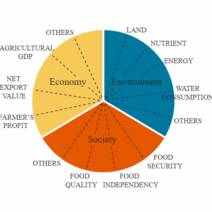In a world that beckons with the allure of distant shores and breathtaking landscapes, the aviation industry stands as a primary facilitator of modern tourism. However, the increasing frequency of flights raises an essential question: Is your flight heating up the planet? Tourism’s contribution to global warming is more significant than many realize, underscoring the need for a deeper understanding of our travel choices.
The aviation sector accounts for approximately 2-3% of global carbon dioxide emissions, a figure that is projected to increase as air travel continues to proliferate. Each flight emits a hefty amount of greenhouse gases, particularly carbon dioxide, but also includes other pollutants such as nitrogen oxides. Together, these emissions catalyze climate change, impacting global temperatures and hindering efforts to combat the environmental crisis.
When we consider the cumulative effect of emissions over time, it becomes evident that aviation serves as a considerable contributor to the escalating temperatures of our planet. One might ponder why tourism, often viewed as a harmless leisure activity, elicits such reprehensible environmental consequences. The answer lies not only in the sheer volume of air travel but also in the characteristics of the aviation industry itself.
Flying is unique. Unlike driving a car or using public transportation, which often have more viable eco-friendly alternatives, air travel is singularly reliant on fossil fuels. Aviation fuels are derived from crude oil, a non-renewable resource that releases a vast amount of carbon when combusted. The high-altitude emissions of aircraft exacerbate the greenhouse effect, as they occur in the upper troposphere where they have a more pronounced warming effect compared to ground-level emissions.
Consider the allure of the destinations that tantalize travelers. From the sun-kissed beaches of the Caribbean to the snow-capped peaks of the Alps, these locations are not merely enticing; they are often exquisitely sensitive to climate shifts. Increased tourism can lead to heightened resource consumption, such as water usage in arid regions, which exacerbates climate challenges. It is a paradox: to explore nature’s wonders often leads to their degradation.
Yet, the impact of tourism extends beyond the carbon footprint of flights alone. The infrastructure that supports the industry—hotels, restaurants, and transportation systems—also contributes significantly to greenhouse gas emissions. The construction and maintenance of tourism facilities often disturb local ecosystems, leading to habitat loss and other environmental stressors. It fosters a cycle of dependence on fossil fuels, perpetuating the emissions that ostensibly entice tourists to visit these very locations.
In recent years, the concept of ‘flygskam’ or flight shame has emerged, addressing the public’s growing awareness of the environmental toll of air travel. This movement encourages individuals to reconsider their travel choices, advocating for more sustainable modes of transport such as trains or buses, particularly for shorter distances. Even so, the aggregation of personal choices can feel inconsequential in light of the systemic challenges underpinning our global reliance on air travel.
To truly tackle the conundrum of tourism’s climate impact, it requires a multifaceted approach. Policy interventions at national and international levels are crucial. Governments must enforce stricter regulations targeted at reducing emissions from the aviation sector while promoting greener technologies like sustainable aviation fuels (SAFs). Various aviation companies are currently exploring innovations to enhance fuel efficiency, such as more aerodynamic aircraft designs and electric planes. However, these advances need broader implementation support to catalyze meaningful change.
Furthermore, the incorporation of carbon offset programs offers a relatively straightforward mechanism for travelers to mitigate their environmental impact. Although offsetting does not eliminate emissions, it allows individuals to invest in projects that promote renewable energy, reforestation, or conservation efforts, effectively balancing some of the carbon footprints they incur while flying. Engaging travelers in these programs cultivates a sense of responsibility, urging them to consider the full scope of their travel habits.
Additionally, tourism operators hold immense power to drive change. By embracing sustainable tourism practices—such as ecotourism or supporting local communities—tourism businesses can attract environmentally-conscientious travelers while fostering stewardship of natural resources. Education and awareness campaigns can further enlighten travelers about their choices and the repercussions of their actions, thus nurturing a culture of accountability.
Ultimately, addressing the conundrum of aviation’s role in climate change is critical for the sustainability of both the tourism sector and the environment. The enchanting allure of travel must be balanced with an ethical approach to exploration, one where individuals consider not only their destinations but the broader implications of their journeys. As the discourse around climate change evolves, tourists can emerge as informed advocates for the environment, ensuring that their adventures do not come at the expense of the very planet that offers them these wondrous experiences.
In conclusion, while the sophistication of modern travel continues to evolve, the stark reality remains: each flight contributes to the atmospheric changes that threaten our planet. A historical fascination with faraway lands must be introspective, recognizing the fragility of Earth amidst our wanderlust. Each traveler holds the potential for transformative change—both within themselves and in the industries they support. The question now is not whether we should travel, but how we can do so responsibly.




